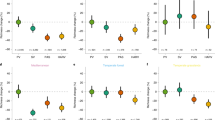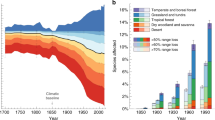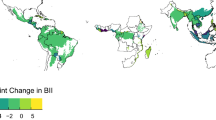Abstract
Biologists have identified 25 areas, called biodiversity hotspots, that are especially rich in endemic species and particularly threatened by human activities. The human population dynamics of these areas, however, are not well quantified. Here we report estimates of key demographic variables for each hotspot, and for three extensive tropical forest areas1 that are less immediately threatened. We estimate that in 1995 more than 1.1 billion people, nearly 20% of world population, were living within the hotspots, an area covering about 12% of Earth's terrestrial surface. We estimate that the population growth rate in the hotspots (1995–2000) is 1.8%?yr-1, substantially higher than the population growth rate of the world as a whole (1.3%?yr-1) and above that of the developing countries (1.6%?yr-1). These results suggest that substantial human-induced environmental changes are likely to continue in the hotspots and that demographic change remains an important factor in global biodiversity conservation. The results also underline the potential conservation significance of the continuing worldwide declines in human fertility and of policies and programs that influence human migration.
This is a preview of subscription content, access via your institution
Access options
Subscribe to this journal
Receive 51 print issues and online access
$199.00 per year
only $3.90 per issue
Buy this article
- Purchase on Springer Link
- Instant access to full article PDF
Prices may be subject to local taxes which are calculated during checkout


Similar content being viewed by others
References
Myers,N., Mittermeier,R. A., Mittermeier, C. G., da Fonseca,G. A. B. & Kent,J. Biodiversity hotspots for conservation priorities. Nature 403, 853–858 (2000).
Myers,N. Threatened biotas: hotspots in tropical forests. Environmentalist 8, 178–208 (1988).
Myers,N. The biodiversity challenge: expanded hot-spot analysis. Environmentalist 10, 243–256 ( 1990).
Mittermeier,R. A., Myers,N., Thomsen,J. B., da Fonesca,G. A. B. & Olivieri, S. Biodiversity hotspots and major tropical wilderness areas: approaches to setting conservation priorities. Conserv. Biol. 12, 516–520 ( 1998).
Mittermeier,R. A. in Biodiversity (eds Wilson, E. O. & Peter, F. M.) 145 –154 (National Academy Press, Washington, DC, 1988).
Mittermeier,R. A., Myers,N., Robles Gil,P. & Mittermeier,C. G. Hotspots: Earth's Biologically Richest and Most Threatened Ecosystems (Cemex, Mexico, D.F., 1999).
Repetto,R. The “Second India” Revisited: Population, Poverty, and Environmental Stress Over Two Decades (World Resources Institute, Washington, DC, 1994).
Myers,N. in Population—The Complex Reality (ed. Graham-Smith, F.) 117 –135 (Royal Society, London, 1994).
Stedman-Edwards,P. The Root Causes of Biodiversity Loss: An Analytical Approach (Worldwide Fund for Nature, Washington, DC, 1997).
Tobler,W., Deichmann,U., Gottsegen,J. & Maloy,K. The Global Demography Project Tech. Rep. No. 95–6 (National Center for Geographic Information Analysis, Univ. California, Santa Barbara, 1995).
Newman,J. L. & Matzke,G. E. Population: Patterns, Dynamics, and Prospects (Prentice-Hall, Englewood Cliffs, 1984 ).
U.N. Population Division World Population Prospects: the 1998 Revision (United Nations, New York, 1998).
Acknowledgements
We thank A. Bornbusch, D. Blockstein, F. Meyerson, R. Mittermeier, N. Myers and D. Sperling for comments on the manuscript, and K. Sebastian and M. Bartels for solving numerous GIS problems encountered during this research.
Author information
Authors and Affiliations
Corresponding author
Rights and permissions
About this article
Cite this article
Cincotta, R., Wisnewski, J. & Engelman, R. Human population in the biodiversity hotspots. Nature 404, 990–992 (2000). https://doi.org/10.1038/35010105
Received:
Accepted:
Issue Date:
DOI: https://doi.org/10.1038/35010105
This article is cited by
-
Built vs. Green cover: an unequal struggle for urban space in Medellín (Colombia)
Urban Ecosystems (2024)
-
Predicting amphibian and reptile distributions and species richness across urban parks in the eastern United States
Urban Ecosystems (2024)
-
Urbanization related changes in lepidopteran community
Urban Ecosystems (2024)
-
Integrating patch stability and network connectivity to optimize ecological security pattern
Landscape Ecology (2024)
-
Population structure and genetic diversity of the endangered fish black shinner Pseudopungtungia nigra (Cyprinidae) in Korea: a wild and restoration population
Scientific Reports (2023)
Comments
By submitting a comment you agree to abide by our Terms and Community Guidelines. If you find something abusive or that does not comply with our terms or guidelines please flag it as inappropriate.



